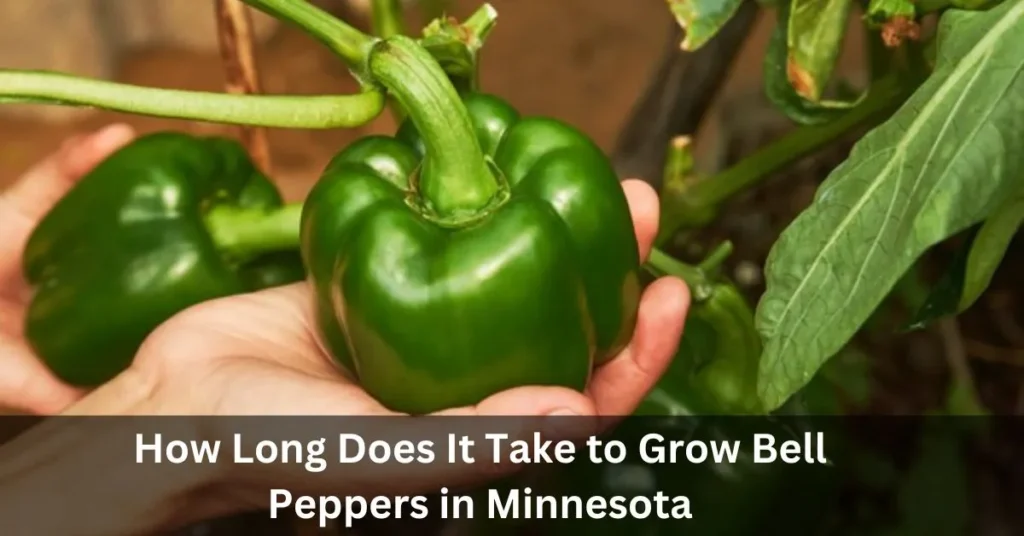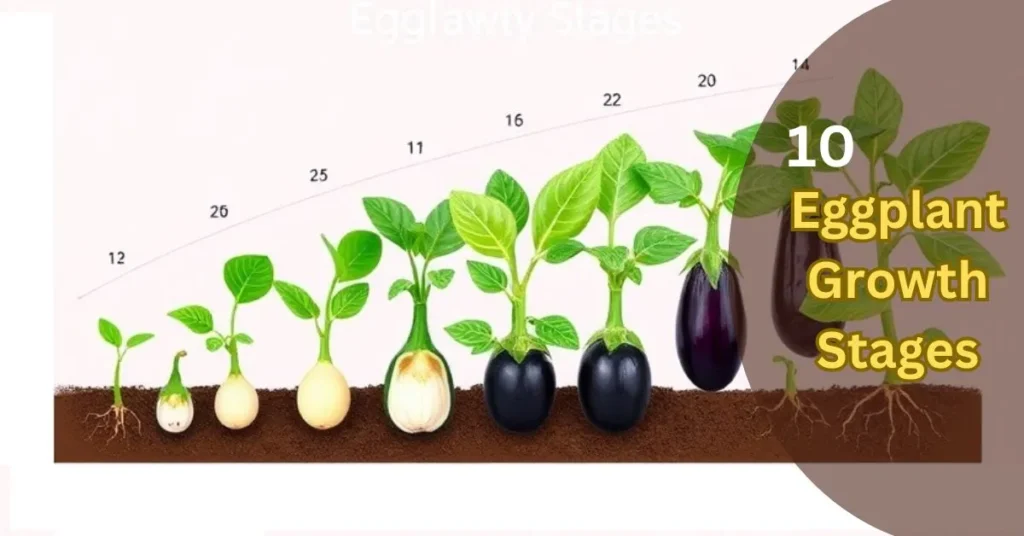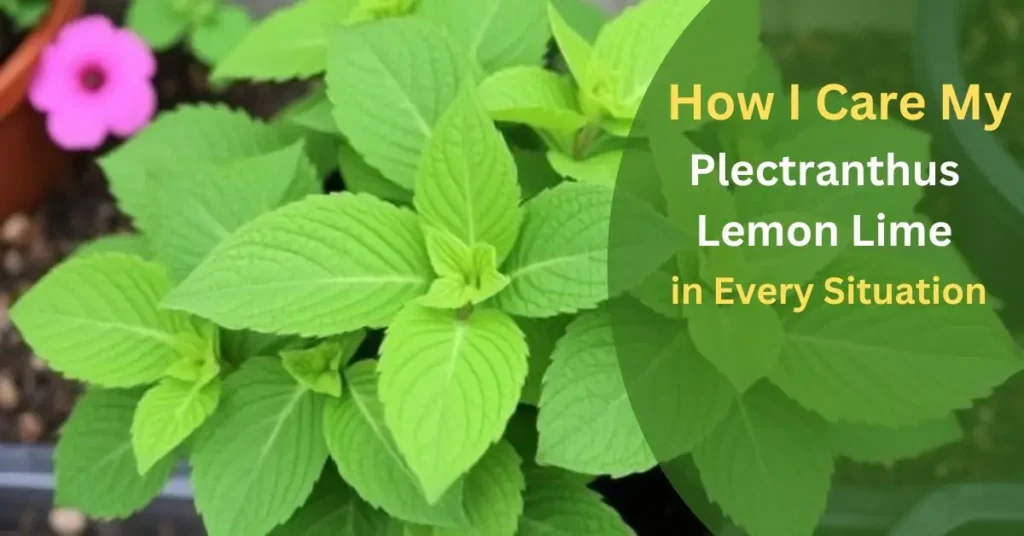Growing bell peppers in Minnesota can be a rewarding yet patient process. These tropical plants thrive in the warm season but require proper care to mature, as they are often grown as annuals.
In Michigan gardens, many gardeners find peppers to be popular due to the wide range of varieties available, from sweet to hot flavors. However, Minnesota‘s cooler climate poses a challenge, as peppers need the warmth of summer to ripen properly.
The typical growth period for bell peppers in Minnesota is around 70 to 90 days from planting. However, it’s important to remember that they are usually harvested when still in their immature green stage for uses like salsas, salads, stuffing, or roasting.
Over time, they will gradually ripen and develop their signature red or other colors at maturity. Peppers grow slowly, and you’ll need to wait for the right conditions to see them reach their full potential, offering an added flavor to many cooked dishes.
Key Information on Growing Bell Peppers in Minnesota
| Aspect | Details |
|---|---|
| Growing Season | Late spring to early fall |
| Optimal Planting Time | Eight to ten weeks prior to the last frost, start seedlings indoors. |
| Time to Maturity | 60–90 days from transplant |
| Temperature Requirements | 70-85°F for optimal growth |
| Watering Needs | 1-2 inches of water per week |
| Soil Requirements | Well-draining, slightly acidic, rich in compost |
| Sunlight | Full sun (at least 6 hours daily) |
| Common Challenges | Cold temperatures, pests (aphids), root rot, blossom end rot, shallow roots |
| Harvest Time | Typically late summer to early fall |
Timing the Growth of Bell Peppers in Minnesota: How Long Does It Take?
Bell peppers are a favorite addition to many dishes, with their vibrant colors and crisp texture. In Minnesota, understanding how long it takes to grow them is crucial due to the unique climate.
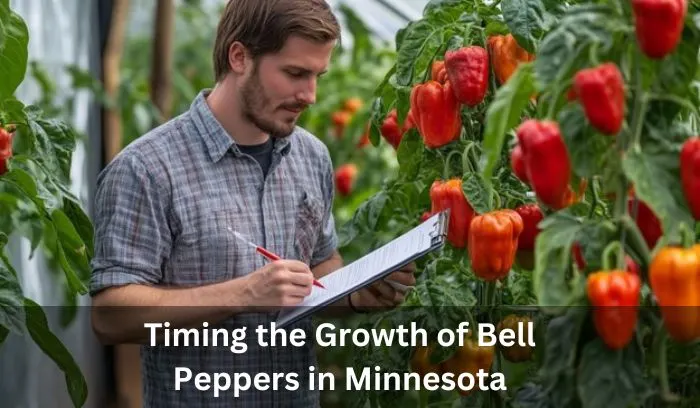
The growth cycle of bell peppers is influenced by several factors, including temperature, soil conditions, and growing methods. In the Minnesota climate, growth can be slower compared to warmer regions. The duration from planting a seed to harvesting the crop generally ranges from approximately 70 to 90 days, although this period can differ based on the specific growing conditions.
To get the best results, it’s essential to explore the specific needs of bell peppers in this region. These plants can yield a plentiful crop if given the proper care and attention. The detailed growth process involves monitoring growth stages, adjusting water levels, and ensuring proper sunlight exposure. With proper care, peppers will mature and be ready for harvest, offering a beautiful addition to any garden or meal.
What Do Pepper Seedlings Look Like?
When pepper seedlings emerge, they usually have a basic appearance, featuring two slender, pointed leaves. These initial leaves are known as seed leaves or cotyledons, which is the more technical term. Their primary role is to help the plant absorb essential nutrients during the early stages of growth. These first leaves are quite basic in shape but are crucial for the survival of the seedling as it begins to establish itself. As the plant grows, the next stage of leaf development begins.
After about a week or so, the first set of true leaves starts to form. These true leaves will look more like regular leaves, with a more recognizable shape for the pepper plant. However, they will still be much smaller than the mature leaves that will develop later on. The appearance of these true leaves signifies the plant’s transition from the early seedling phase to a more established stage of growth.
Understanding the Bell Pepper Growth Cycle in Minnesota
1. Seed Germination (7-14 Days)
The growth of bell peppers in Minnesota starts with seed germination. This crucial step is influenced by several key factors, including the climate and temperature. To begin, you should plant your seeds in a well-draining seed-starting mix. It’s important to keep the temperature steady and warm, ideally between 70-80°F (21-27°C).
In Minnesota, where the growing season is short, this step often requires the use of indoor or greenhouse setups to ensure the ideal conditions for germination. Under these conditions, the seeds will typically germinate within 7-14 days, starting the growth cycle for your bell peppers.
2. Seedling Stage (6-8 Weeks)
After germination, bell pepper seeds begin to grow into seedlings. In Minnesota, where the weather can be unpredictable, this stage often requires using indoor or greenhouse environments to provide the warmth and light the plants need.
These seedlings usually develop their first true leaves around 6-8 weeks after planting. Once they have reached this stage and are strong enough, they can be transplanted into larger pots or directly into the garden.
During this time, it’s crucial to keep the seedlings in the right conditions for them to thrive. A warm, well-lit space encourages growth and ensures they are ready for their next stage. After about 6-8 weeks, your seedlings should be healthy and prepared for the outdoor transition.
3. Transplanting (2-3 Weeks)
In Minnesota, transplanting your bell pepper seedlings typically occurs when the last frost has passed and outdoor temperatures are consistently above 50°F (10°C). This usually happens about 2-3 weeks after the last frost date in the region. It’s important to wait for this moment because planting too early in cold conditions can stunt growth or harm the seedlings.
During this time, the young plants are ready to move into their final growing spots. Once the weather is warm and stable, your peppers can be transplanted into the garden, giving them the best start for healthy growth.
4. Vegetative Growth (2-3 Months)
In Minnesota, bell peppers go through a key vegetative growth phase, lasting about 2-3 months after transplanting. During this time, the plants focus on developing their leaves, stems, and roots.
This process helps create a strong foundation for the plant, which is essential for supporting future fruit production. The growth during this phase is important for the plant to gather energy and resources that will be used when it begins producing peppers.
As the bell peppers continue to grow, they build a sturdy structure that will eventually support the weight of the fruit. The healthy development of roots ensures the plants can absorb enough nutrients and water, which in turn supports robust leaf and stem growth. This vegetative stage is crucial to set the plants up for successful fruiting later on.
5. Flowering (6-8 Weeks)
After transplanting, bell pepper plants in Minnesota begin to produce flowers within 6-8 weeks.This phase is essential for the peppers’ growth moving forward. The flowers are important for pollination, which is necessary for the eventual development of the fruit.
Without proper pollination, bell peppers won’t be able to develop properly. The timing and environmental factors, like temperature and light, can influence how well the flowers bloom and how successful the pollination process is.
At this stage, the plant’s energy is focused on supporting the flowers, which will eventually turn into peppers. After successful pollination, the fruit will begin to develop, marking a key milestone in the bell pepper growth cycle. Ensuring that the plants receive enough nutrients and that the weather conditions are favorable is vital during this phase to ensure a healthy crop.
6. Pollination (1-2 Weeks
In Minnesota, pollination plays a vital role in the successful growth of bell peppers. The short growing season means that some bell pepper varieties may need extra help to ensure proper pollination.
While natural pollinators like bees are important, they can sometimes be scarce, especially when the season is brief. In such cases, indoor methods of pollination can be used to support the process. These methods are often required to help the plants thrive and produce fruit in Minnesota’s unique climate.
When pollination happens successfully, it sets the stage for the next stages of growth. With the right assistance, even in regions with a short season, bell peppers will grow strong and yield a good harvest.
7. Fruit Formation (2-3 Weeks)
After pollination occurs, bell peppers in Minnesota begin to develop. The little green peppers take around two to three weeks to form and begin to grow. During this time, the tiny peppers begin to take shape, growing bigger each day.
This stage is crucial as it marks the start of fruit formation, and the peppers gradually change from their initial size to their full shape.
The fruit formation process is exciting as it shows how the plants are progressing. The small green peppers will eventually mature into the vibrant, colorful peppers we recognize. As the growing continues, the peppers’ development ensures that they are ready for the next stages, setting the stage for a successful harvest.
8. Ripening (50-85 Days)
The ripening process of bell peppers in Minnesota is a fascinating journey that typically takes between 50 to 85 days. The exact timeline varies depending on a variety of factors such as the growing conditions and the specific variety of bell peppers you’re cultivating. Once the peppers start to mature, they begin to transition from their initial green color to their final shade. The transformation is one of the most rewarding parts of growing peppers, as you get to see them evolve into vibrant hues.
The final colors of bell peppers can include shades of red, yellow, orange, and sometimes even purple, which is influenced by the variety and growing conditions. Some pepper types may take longer than others to fully ripen, with environmental factors such as temperature and light playing a significant role in the speed of the process. For instance, if the growing season is shorter, you may notice that peppers take longer to develop and reach their full color.
During this period, it’s important to ensure that the peppers receive adequate care, with proper water and nutrients, to help them reach their full potential. Monitoring the ripening process closely can help you harvest peppers at the peak of their flavor and texture, ensuring that they are both delicious and beautiful when fully ripe.
Best Time to Plant Bell Peppers in Minnesota
In Minnesota, the best time to plant bell peppers is after the last frost date, which typically falls in mid-to-late May. To ensure a successful harvest, it’s essential to start pepper seeds indoors around late February to early March.
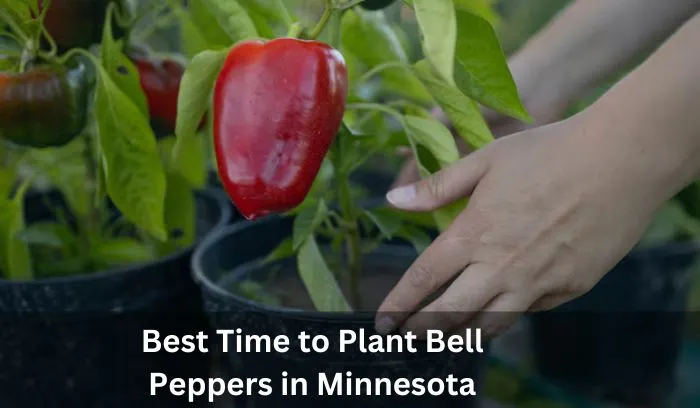
This will give your seedlings ample time to grow and be ready for transplant when the weather becomes warm enough. By starting early, you’ll give your plants a strong head start and allow them to thrive outdoors once the temperatures are just right.
To make sure they are ready for transplanting, keep an eye on the weather and monitor the forecast closely. It’s crucial that the soil is warm enough before moving your plants outside, so make sure you’re planting when conditions are ideal for healthy growth. Starting indoors and timing your transplanting well will result in the best chance of producing vibrant, healthy bell peppers in the short growing season of Minnesota.
Factors Affecting Bell Pepper Growth Time in Minnesota
Variety
The variety of bell peppers you choose plays a crucial role in how fast they grow in Minnesota. Different varieties have different growth rates, which can significantly affect how long it takes for your peppers to mature.
Some bell peppers are better suited for the shorter growing season in Minnesota, meaning they can handle cooler temperatures and still produce a good yield. This is especially important for gardeners who need their peppers to grow quickly, as the growing season in Minnesota can sometimes be shorter than in other places.
For example, some varieties of bell peppers may mature in just a few weeks, while others may take longer. Choosing a variety with a faster growth rate will help you get the most out of your growing season. If you’re in Minnesota, it’s important to look for varieties that can adapt to the local climate and grow effectively in a shorter growing season.
Climate
The climate in Minnesota can significantly impact the growth rate of bell peppers. Due to the state’s cooler conditions, the peppers may not grow as quickly as they would in warmer regions. This is especially true in the short growing season, which doesn’t allow for as much time for growth.
Indoor spaces or greenhouse environments can help mitigate these challenges. By controlling the temperature, these solutions can provide a warmer environment, making it easier for peppers to thrive despite the cooler climate.
To adapt to Minnesota’s growing conditions, some gardeners use greenhouse methods to extend the growing season. These controlled environments help to offset the effects of the cooler climate, allowing the bell peppers to develop at a steady pace. By managing these external factors, it’s possible to support bell pepper growth even in areas with a limited growing window.
Growing Conditions
For bell pepper plants to grow successfully in Minnesota, providing the right growing conditions is crucial. Factors like soil quality, sunlight, and temperature control play a major role in expediting the growth process. When these conditions are met, the plants can thrive and develop faster, ensuring a better yield.
A well-balanced combination of good soil, enough sunlight, and the ability to manage temperature can make all the difference in how quickly bell peppers reach their full potential.
In my experience, adjusting the temperature control and ensuring the soil quality is ideal often leads to stronger plants. A sunny spot with the right balance of water and temperature can significantly speed up the growth rate of bell pepper plants. By providing these growing conditions, we can help the peppers grow faster and more healthily, which is especially important for Minnesota’s shorter growing season.
Nutrition
For bell peppers to grow well in Minnesota, providing the right nutrients and fertilization is essential. These factors help encourage robust growth and ensure that the plants reach their full potential.
It is crucial to offer these nutrients at the right times to keep the plants healthy and support their development throughout the growing season. Proper fertilization at key stages of growth helps ensure the peppers have everything they need to thrive, leading to better yields and faster development.
In Minnesota, where the growing season is often shorter, timing is critical. By giving bell peppers the right care at the right time, we can support them in overcoming challenges posed by the climate and make the most of the growing period available. Ensuring the plants get the right balance of nutrients can significantly impact how quickly they grow and when they are ready for harvest.
Indoor or Greenhouse Cultivation
In Minnesota, the weather can be unpredictable, and the controlled environment of a greenhouse or indoor space can make a big difference in how bell peppers grow. These environments allow growers to have precise control over factors like temperature and light, which are essential for the growth of the plants.
By adjusting these conditions, it’s possible to create an optimal setting for the peppers to thrive, accelerating their growth and potentially shortening the time it takes to reach harvest.
When growing bell peppers in such controlled spaces, the temperature can be kept steady, preventing the plants from getting too cold, which is crucial in Minnesota’s cooler climate. Likewise, having full control over light ensures the peppers get enough energy for healthy development.
These adjustments not only improve the growth rate but also help in growing more consistent and high-quality peppers. The ability to regulate these factors allows for a longer growing season, potentially speeding up the overall process from seed to harvest.
Tips for Faster Bell Pepper Growth in Minnesota
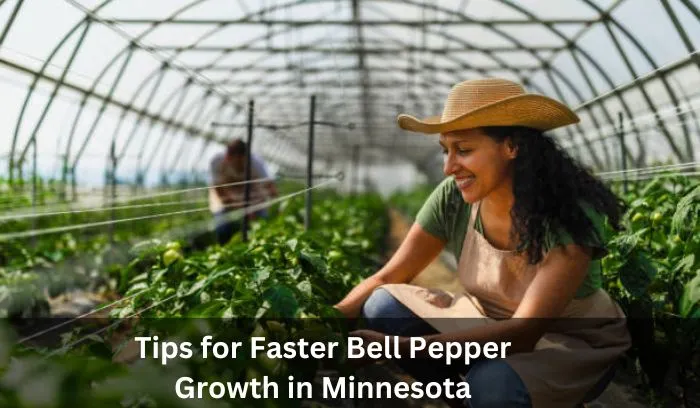
Early-Maturing Varieties
To speed up the growth of bell peppers in Minnesota, one key tip is to choose early-maturing varieties. These varieties are designed to reach maturity faster, allowing them to grow within the short growing season. By selecting peppers that mature early, you can expedite the overall growth process, ensuring that you get a good harvest before the colder months arrive. It’s a simple yet effective way to make the most of the growing time available in Minnesota.
If you’re looking for bell peppers that can thrive in a short period, consider starting with varieties specifically bred for fast maturation. This will help you maximize your harvest even with a limited growing season.
Maximizing Growth with Indoor or Greenhouse Cultivation
To speed up bell pepper growth in Minnesota, consider using indoor or greenhouse environments. These controlled spaces allow you to extend the growing season by providing optimal conditions for the plants. With temperature control and the right amount of light, you can help the plants grow faster and more effectively.
Whether you’re growing during Minnesota’s cold months or just need to ensure the plants have the best possible care, indoor or greenhouse cultivation is a smart choice. It helps maintain the ideal conditions, leading to a quicker, more robust harvest.
By utilizing these environments, you can overcome the challenges of a shorter growing season in Minnesota. Greenhouse farming, in particular, gives you the flexibility to simulate the best climate for bell peppers, ensuring that the plants thrive even outside their natural growing periods.
Soil and Fertilization
To grow healthy and productive bell pepper plants in Minnesota, it’s crucial to focus on soil and fertilization. Make sure the soil is of high-quality, as this helps the plants absorb essential nutrients better.
Providing the necessary fertilizers at the appropriate times ensures the plants get the nutrients they need to thrive. Without proper access to the right soil and fertilizers, the growth of your bell peppers will be slow and weak. Always ensure that the soil remains well-drained and rich in organic matter for optimal growth.
Pruning and Maintenance
To encourage faster growth of bell pepper plants in Minnesota, it is essential to focus on pruning and maintenance. Regularly removing dead or damaged leaves and stems helps to direct the plant’s energy toward more vital areas, such as fruit production. By doing so, you ensure that the plant develops a strong and healthy structure.
This not only helps the plant grow better but also leads to a higher yield of peppers, especially in the short growing season of Minnesota. Proper maintenance ensures your plants remain productive throughout their growth stages.
When you prune your bell peppers, make sure to cut back any weak growth and focus on strengthening the core structure. This will help your plants handle more fruit and stay healthy through Minnesota’s fluctuating weather. Keep an eye on your plants’ development and adjust your pruning as needed to maintain the best possible growing conditions.
Indoor Pollination
Growing bell peppers in Minnesota can be a challenge due to the short growing season and the scarce natural pollinators. To tackle this, using strategic techniques can make all the difference. One effective approach is indoor pollination.
During the growing season, it’s essential to consider methods that encourage proper fruit development, especially when environmental factors aren’t ideal.
From my experience, gently shaking the plants or using a small brush to transfer pollen can significantly assist pollination indoors. These simple methods mimic the work of pollinators and ensure your peppers thrive. If you’re looking for consistent results, try these techniques in controlled conditions to improve fruit development and maximize your harvest.
Harvesting Bell Peppers in Minnesota
When it comes to harvesting bell peppers in Minnesota, the timing truly depends on your personal preference and the desired ripeness of the fruit. You can choose to pick them at the green stage, when they are still slightly immature, or wait until they are fully mature and have developed their colorful form. Each stage offers unique flavors and uses, so it’s all about what works best for your needs.
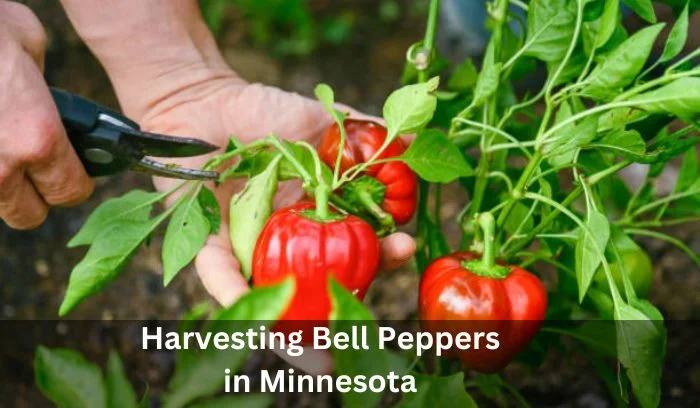
From my experience, ensuring a careful harvest is key. Whether you prefer them green or wait until they are perfectly mature, handle the peppers gently to avoid damage. Proper timing not only ensures better flavor but also keeps the plant healthy for more production. In Minnesota, paying attention to the peppers’ form and ripening progress is a simple yet effective way to enjoy a successful harvest.
Green Peppers
Harvesting green bell peppers in Minnesota is straightforward when you know the right steps. Ensure the peppers are fully formed, feel firm, and have reached the desired size. From my experience, using a sharp pair of garden shears or a knife makes the process easier and keeps the plant healthy. Carefully cut the pepper, leaving a small section of the stem attached, which helps maintain its freshness longer.
Learning the timing and technique is crucial. When the peppers look just right, avoid pulling them by hand. Instead, use the proper tools like shears or a knife to minimize damage to the plant. After the harvest, you’ll notice how keeping a part of the stem attached improves the pepper’s longevity and quality. Growing and picking these peppers can be a rewarding process when done with care.
Colored Peppers
In Minnesota, colored bell peppers such as red, yellow, orange, or purple need to be fully ripened on the plant before they are ready for harvest. The key to knowing when they are ready is their full color—a sign that they have developed properly.
Once they are firm and their vibrant color has fully emerged, you can use the same method as for green peppers to cut them from the plant. Whether it’s your first time growing colored peppers or you’re a seasoned gardener, it’s always rewarding to see the peppers transform into their final, rich hues.
These colored peppers require patience, but the wait is worth it. Be sure to keep an eye on the peppers as they ripen, ensuring that they’ve reached the desired shade before picking them from the plant. Once harvested, these peppers add not just flavor but also beautiful colors to your kitchen.
Handling
When it comes to harvesting bell peppers, the process requires careful attention to avoid any damage. It’s essential to handle the peppers gently during harvesting. You don’t want to apply pressure or cause bruising, as this can affect the plant and the quality of the peppers.
Always cut the peppers carefully from the plant, leaving the stems intact, and avoid pulling them by the stem. This will help preserve both the plant and the peppers for future harvests. If you’re growing bell peppers in your garden, it’s a good idea to check the peppers regularly to ensure they are ready for picking at the right time.
After harvesting, the next step is proper storage. To maintain your peppers’ freshness and crunch, store them in a cool, dry location. You can also opt for the refrigerator if you want them to last a bit longer.
Storing bell peppers in the refrigerator helps to maintain their freshness, preventing them from wilting or losing their crisp texture. Just make sure that the peppers are not exposed to moisture, as that can cause them to spoil faster. By following these simple handling tips, you can enjoy your peppers for longer and get the best out of your garden’s harvest.
Tips on Starting Pepper Seeds Indoors
When you start pepper seeds indoors, make sure to plant them about a quarter inch deep in a moist environment. Keep the seeds warm, ideally between 80F and 90F, to encourage germination.
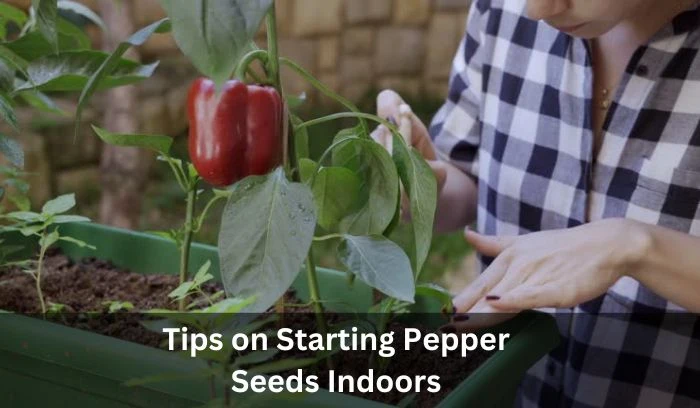
A germination heating mat can help maintain this temperature, but if you don’t have one, placing the seed tray on a warm surface, like the top of a refrigerator, will work too. Keep in mind, light isn’t needed until the seeds begin to grow. After the first seedling appears, you can place them under a grow light.
As the seedlings grow, be mindful of the Minnesota April sunlight, which may not provide enough light for the plants, causing them to become leggy. If you see buds forming, pinch them off to encourage healthier growth.
By the time you are ready to transplant, aim to have buds that are not yet open flowers on your pepper plants. This will help them settle into their new environment more smoothly.
How to grow peppers from fresh seeds
If you’re thinking about growing peppers from fresh seeds, it’s important to start at the right time. Start indoors six to ten weeks prior to the latest typical date of frost.. Use a sterile, soilless germination mix in a flat, and consider adding compost or other organic matter to the soil.
After planting, push the seeds ¼ inch deep, and remember to water immediately. Water regularly, aiming for 1-2 inches of water each week. For the best growth, make sure the seedlings get bright overhead light so their stems don’t elongate or lean over.
Once the seedlings reach 7-8 weeks, it’s time to harden them off. Lower the temperature to 60-65°F for about 1 week before transplanting. Once the true leaves emerge, space the seedlings 2-3 inches apart by thinning them. Once you’ve harvested the seeds from a ripe pepper, allow them to dry on a paper towel. Then, store them in an envelope in a warm, dry place until you’re ready to use them.
Can I plant pepper seeds from a fresh pepper?
Yes, fresh peppers can be used to plant pepper seeds. Simply scrape the seeds from a ripe pepper, and let them dry for a few days. Once dried, you can plant them in soil. However, keep in mind that if the pepper is a hybrid variety, the plants that grow from its seeds may not produce the same peppers as the parent plant.
It’s important to check for hybrid varieties when using store-bought peppers. These hybrids might not result in the exact same pepper. For the best germination, ensure the pepper is fully ripe before harvesting the seeds. After removing the seeds, spread them on a paper towel and let them dry before planting. Once dried, store the pepper seeds in a cool, dry place until you’re ready to plant them.
How to grow peppers in pots
To grow peppers in pots, choose a large pot with drainage holes, at least 12 inches in diameter and 20–40 cm deep. Use a well-draining potting mix with perlite, compost, and horticultural sand. When the top inch of soil is dry, water frequently. Add mulch to retain moisture and stabilize the soil temperature.Ensure your peppers get between six and eight hours of sunlight daily. Use a heat mat for better seed germination.
| Step | Action |
|---|---|
| Choose a pot | Large, with drainage holes |
| Prepare the soil | Well-draining mix with perlite & compost |
| Water | Regularly, check the top inch of soil |
| Mulch | Add mulch to retain moisture |
| Sunlight | 6-8 hours per day |
How To Care For Pepper Seedlings
Water
When caring for pepper seedlings, the most important thing is to ensure they have consistent moisture. You need to keep the soil moist, but be careful not to let it become soggy or wet soil. The top of the soil should be allowed to dry out a bit between waterings, but make sure it doesn’t dry out completely.
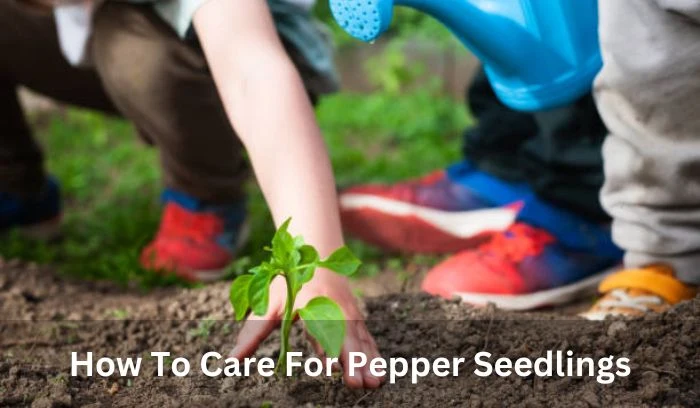
One of the best tips for keeping the right moisture level is to use a moisture gauge to measure the soil’s moisture. If you accidentally overwater your seedlings, simply take the tray lid off and use a fan on low to help the soil dry out and avoid soggy conditions.
Keeping the soil just right can be tricky, but by following these simple steps, your pepper seedlings will have the perfect environment to grow healthy and strong.
Light
When growing pepper seedlings, it’s crucial to provide the light they need to grow strong and healthy. Proper light is key to prevent the plants from becoming leggy or stretching towards a window. Instead of relying solely on natural sunlight, consider using artificial grow lights to ensure the light is consistent.
This is especially important when using a heat mat for faster germination, as sun exposure alone might not be enough to meet the ideal temperature for growth. With outlet timers, you can set your grow light to provide 14-16 hours of light per day, promoting strong, compact seedlings.
It’s also important to maintain proper conditions to ensure the growth of healthy plants. Full sun and warm temperatures are best for pepper seedlings, but during colder months or when natural sunlight is insufficient, supplementing with artificial light can make a huge difference.
The tray where your seedlings are planted should be placed in a bright, warm area to help them thrive. The extra light will prevent the seedlings from becoming weak and promote fast germination while ensuring they stay straight and compact instead of stretching out due to lack of light.
Fertilizer
When pepper seedlings start to grow and their true leaves begin to form, it’s time to start fertilizing. At this stage, don’t jump into using a full strength dose right away. Begin with a weak solution and gradually increase the strength over time.
This slow approach helps the seedlings adjust without getting overwhelmed. It’s important to give them just the right amount to prevent any issues as they continue to grow larger.
As you observe your seedlings grow, you’ll notice their needs change. At first, they require less, but as they get bigger, you can increase the dose slowly, making sure not to overwhelm them. By giving your pepper seedlings the correct amount of fertilizer at the right time, you’ll help them flourish and develop into healthy, strong plants.
Air Circulation
Once the seeds in the flat begin to germinate and start growing, it’s time to provide some airflow for your pepper seedlings. You can remove the lids and use an oscillating fan set on the lowest setting. This will help strengthen the seedlings, preventing issues like mold from developing in the trays.
For better control, you can plug the fan into the same timer as your lights. This way, the fan will run for the same period as the light cycle. Alternatively, you may prefer to run the fan for a shorter amount of time, depending on your needs. This simple adjustment can make a big difference in your plants’ health and growth.
Potting Them Up
Once your pepper seedlings have grown tall and outgrown their tray, it’s time to pot them into larger containers. This gives them plenty of room to grow and continue developing strong roots.
I prefer using plantable pots, as they make it easy to transplant the seedlings into the garden later. If you’re looking for a sustainable alternative to traditional peat, try options like coco coir or cow pots.
Alternatively, small plastic nursery pots are a good choice, especially since they are reusable. You can also repurpose recycled containers, such as yogurt cups or milk cartons. Just be sure to poke some drainage holes in the bottom to prevent water from collecting and damaging the plants. These simple steps will help your seedlings thrive as they continue to grow!
Common Challenges Growing Bell Peppers in Minnesota
Growing bell peppers in Minnesota can present a few common issues that every When growing bell peppers in Minnesota, one of the biggest challenges is the climate. The state’s cold winters and short growing season can make it tricky to get peppers to maturity.
The season typically begins in late spring and stretches into early fall, so careful planning is needed. To ensure success, peppers require well-draining soil that is slightly acidic, rich in compost, and a location that receives plenty of full sun.
Unfortunately, even with the right soil and sunlight, challenges like pests, especially aphids, can quickly arise. These soft-bodied insects suck the juice from the plants, stunting their growth.
In addition to pests, other environmental factors can cause problems, such as root rot and fungal disease from overwatering. For healthy growth, peppers need about 1–2 inches of water weekly, but overwatering can damage the plants and lead to shallow roots, resulting in poor fruit quality.
Blossom end rot is another concern, often caused by a calcium deficiency that can worsen with high salinity in the soil. Other signs of distress include yellow leaves, which can indicate issues like low temperatures, lack of nitrogen, or improper watering. Using mulching around the plants helps prevent weeds, but if left unchecked, these can steal vital nutrients and water.
FAQs
Bell peppers usually take about 60 to 90 days to fully grow. Many home gardeners opt for starter plants from a garden nursery instead of starting from seed, as it speeds up the process. The growth time depends on factors like temperature, sunlight, and soil quality, but whether grown in a garden or containers, they thrive best in a warm, sunny environment.
Bell pepper plants typically produce six to eight or more fruit per plant. They have a short storage life, lasting one to two weeks. For storing, keep them in cool, moist conditions (around 45°F to 50°F with 85 to 90 percent relative humidity). You can also wash, cut, and freeze them for longer storage.
Bell peppers need deep watering of one to two inches per week in warm weather. In hotter climates, gardeners may need to water them twice a day. This helps ensure they flourish, as too much heat can prevent healthy growth. Consistent watering is necessary to keep them thriving.
Bell peppers come in various colors, sizes, and varieties, making them one of the trickiest vegetables to harvest at the right time. Depending on the year, pepper type, and flavor preference, you can harvest them up to six different times. The best time to harvest depends on the size and maturity of the peppers, which can vary based on growing conditions.
In America, they are called bell peppers, while in the UK, they are referred to as capsicums. Green peppers are harvested at an intermediate stage, while yellow and orange ones are sweeter. When fully ripe, they turn red and have the highest vitamin and antioxidant content.
Conclusion
Bell peppers in Minnesota are a popular warm-season plant but require proper care to thrive. They typically take 70 to 90 days to mature, with harvesting occurring in the immature green stage. The cooler climate in Minnesota can make it harder for peppers to ripen, as they need summer warmth.
The growth cycle begins with seed germination, which should occur at 70-80°F (21-27°C) in a well-draining seed mix. After 6-8 weeks, seedlings can be transplanted. The vegetative growth phase lasts 2-3 months, where leaves, stems, and roots develop, followed by flowering for pollination, which is essential for fruit formation.
See Also:
Lilies Slow to Break Ground? Here’s Why and How to Fix It!
What Do Carrots Look Like When They Start to Grow

